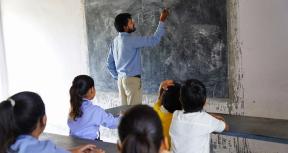This blog is part of the series Learning from Fragility that aims to inform discussions at the upcoming Fragility Forum by exploring lessons from past support for development in fragile and conflict settings.
A staggering 80% of the world’s extreme poor are estimated to live in countries affected by fragility, conflict, and violence (FCV) by 2030. Despite these conditions, attempts at more effective development cooperation to address the crisis of fragility have largely failed to invest in country-level platforms to achieve greater unity of effort. Instead, aid is often delivered in FCV-affected countries through uncoordinated, short-term, and one-off projects, combined with scattered technical assistance in the face of systemic breakdowns in institutions, markets, and social cohesion.
Country platforms are government-led coordination bodies that establish a center of gravity for governments and partners to make sense of complex political, social, and economic realities, agree on shared priorities, and solve collective action problems. Although country platforms have been tried in a range of fragile states over the past two decades, they have not been properly examined, refined, or incorporated into successive development effectiveness agendas.
In a multilateral system under strain, rethinking how international partners can best support national ownership, capacities, coordination, and mutual accountability in FCV settings will be paramount for helping countries exit fragility traps. The G20 is increasingly promoting country platforms, calling for these to boost development impact and private investment in fragile states. The OECD has affirmed the importance of country platforms in a range of fragile contexts. UNDP has committed to supporting country platforms in fragile states and there are prospects for the Resident Coordinator System to follow suit. Also, the World Bank’s first-ever FCV strategy highlighted the importance of country platforms.
Despite widening partner support, there is a pressing need to better understand the country platform approach. This blog highlights the underlying model of country platforms and early efforts to better assess the value, impact, and conditions for the success of these collective action mechanisms.
What country platforms are – and have the potential to be
Country platforms for development cooperation in fragile states have gone by many names and configurations. An underlying, aspirational model can be attributed to many of these country platforms, which promotes the following principles:
- Country ownership and development effectiveness through a high-level steering group led by Presidents or Prime-Ministers and comprised of senior multilateral and bilateral donor officials, implementing partners and representatives of civil society to contribute to a national development plan, collective sense-making of the context, resource mobilization, dialogue, mutual accountability, and troubleshooting.
- A sector level led by government ministers who assemble their own core sector groups of technical experts, operational partners, and societal stakeholders to determine sector policy, resource flows, and “who’s doing what where.”
- A secretariat level led by the Ministry of Planning and staffed by domestic and international experts with analytic, convening, and troubleshooting roles to administer the steering and sector levels and facilitate the achievement of overall development goals.
This common, aspirational model can be gleaned in the examples of several country platforms in fragile contexts from Somalia and Haiti to the Central African Republic, Rwanda, and Sierra Leone. Yet, because there has been no shared doctrine to guide development cooperation through these platforms, there have been many false starts, missteps, and reinventions of the wheel. In Haiti, for example, the post-earthquake country platform had an impressive and highly active steering committee and secretariat but was (externally) designed without ministerial-led sector committees; an omission that was corrected in Haiti’s current CAED platform. In Liberia, the steering committee was functional and inclusive, including NGO and INGO representatives, but the secretariat was too small to administer the cluster committees. In Sierra Leone, the country platform incorporates local government into its configuration, learning of potential relevance to other country platforms. In Somalia, the government-led country platform plays a central and evolving role in steering the country’s development transition and solving collective action problems between partners. The platform’s combination of three pooled funds (World Bank, UN, AfDB) into a common funding facility was highly innovative in harmonizing aid and will be potentially replicated in the Central African Republic. The country’s national development council and national security council were both likely strengthened by the country platform, which necessitated a “learning by doing” process of internal policy formulation, cooperation, and coordination through the councils in strategic response to the platform’s more formalized political dialogue and its aggregation of donor priorities, requests and resource flow, alongside those of local elites, civil society, and investors.
Deepening the effectiveness of these platforms will require more than getting the coordination bodies right: it will ultimately require a new paradigm for development cooperation in the most vulnerable countries.
The current development paradigm focuses primarily on poverty reduction and growth, not risks and resilience which are fundamental dimensions to address in fragile states. In its most recent evaluation of World Bank Engagement in Situations of Conflict, IEG found that the analysis of fragility and conflict drivers, relevant for achieving development effectiveness, have improved. Yet, the client-facing nature and the potentially broad distribution of conflict analyses have sometimes prevented frank assessments, limiting the transmission of conflict considerations into a portfolio and operational decisions. As also noted by IEG, the same paradigm often favors pre-fixed solutions, metrics, and linear timeframes, rather than problem-driven, iterative, and adaptive approaches to complex risks and their root causes. It favors small projects over scalable outcomes and systems reform. While there are positive indications that governments, multilateral institutions, donors, and implementing partners are pivoting to a new paradigm, this pivot is neither complete nor assured. Country platforms must ultimately become a vehicle for more collaborative, resilient, adaptive, and scalable approaches to help fragile states.
The World Bank’s Fragility Forum 2022 and next steps
Gathering the global development community on topics of fragility, conflict, and resilience, the World Bank’s Fragility Forum offers a significant opportunity to advance the dialogue, learning, and implementation of country platforms. The 2020 Fragility Forum began this learning process, where we took stock of government and experts’ insights into Somalia’s country platform. In 2022, the Forum will look both at the challenges and the realities of governance and institution building in FCV settings, including through the lens of 2017 WDR on Governance and the Law’s adaptive and politically-sensitive framework for governance reform. The World Development Report (WDR) on Conflict, Security and Development 2011 placed a high premium on country leadership and on getting country coordination mechanisms right in fragile contexts—comparing various coordination efforts in Africa, Asia, and Latin America.
On March 7th, 2022, 2:30-3:30 PM ET, IEG, Food for the Hungry, and the Busara Center will co-host the webinar “Adaptive Management in Fragile Contexts: Navigating Uncertainty in Hard Places” at the Fragility Forum. The session will examine how adaptive efforts can be applied beyond specific projects and inform both portfolio approaches of governments and partners, as well as country platforms in a bid to better understand, learn and iterate reforms in the face of complex risks and political economies. Please join us by registering for the Fragility Forum here.

Photo: view of Delmas 32, Port-au-Prince, Haiti from 2012. Credit: Dominic Chavez / World Bank.










Add new comment